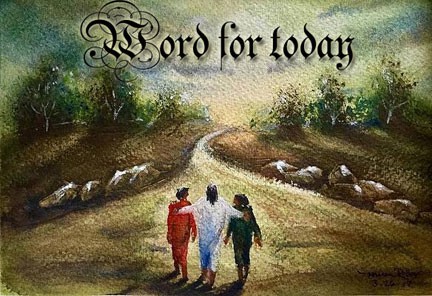Watch
Events
Articles
Market
More
112125 / 29th day of the 8th month 5786
WORD FOR TODAY “do you thirst”: Mat 5:6 "Blessed are those who hunger and thirst for righteousness, for they shall be satisfied.
WISDOM FOR TODAY: Pro 19:28 A worthless witness makes a mockery of justice, And the mouth of the wicked spreads iniquity.
Ask the LORD; if you died today would you get into heaven?
www.BGMCTV.org




BIBLE STUDY --- THE GOOD SHEPHERD
MORE KINGDOM PARABLES
From Matthew 13:34-43
Whatever Yeshua taught the crowds was given through these parables. As an Old Testament prophecy had predicted, He often taught them through such stories. Many years before, the Psalmist had said about the coming Moshiach, [I will speak to them in parables, I will reveal secrets hidden from the beginning of the world.] When the crowds had left and Yeshua had gone home, the disciples came to Him and asked, [Tell us the meaning of the story of the thistles.]
Here is the answer that Yeshua gave: [I am the one who sows the good seed. The field is the world and the good seeds are those who belong to My Kingdom. The thistles are those who belong to Satan, and the enemy who sowed the thistle seed is Satan himself. The harvest is the end of time and the reapers are the angels. As the weeds are gathered into bundles to be burned, so it will be at the end of time. I will send out My angels and they will gather those who practice evil and burn them in a fiery furnace, where people cry and grind their teeth. Then those who belong to YHVH will shine like the sun. If you have ears, you should listen!]
BURIED TREASURE
From Matthew 13:44
Once again Yeshua told a parable. [The Kingdom of heaven is like some treasure which a man found buried in a field. He hid it again, then went away and joyfully sold all that he had so that he could buy that field.]
THE MOST BEAUTIFUL PEARL OF ALL
From Matthew 13:45-46
Here is another story that Yeshua talked about heaven: [The Kingdom of heaven is like a pearl buyer who travelled to many places to buy pearls. On one trip, he found a pearl that was worth more than any other. The man immediately went home and sold everything he had so that he could buy that beautiful pearl.]
A STORY OF A NET
From Matthew 13:47-50
[The Kingdom of heaven is like a great net that is let out into the sea, gathering many kinds of fish into it. When it is full, men pull it to the shore and sit down to sort the fish. The good fish are put into their vessels and the worthless ones are thrown away. This is the way it will be at the end of time. Angels will come to separate the evil people from the godly people and will throw the evil people into a great fire. Then there will be much crying and grinding of teeth.]
TREASURES NEW AND OLD
From Matthew 13:51-52
[Do you understand what I am saying?] Yeshua asked. [Yes,] the people answered. [We do understand.] Then Yeshua replied, [Every disciple of Mine who first studies the Law is like the master of a house who has both old and new treasures in his storehouse.] Yeshua was saying that both the old Covenant and the new would be like treasure houses to such a person.
COMMENTARY
FISHING ON THE SEA OF GALILEE
Fishing was not playing; it was hard work. The fisherman did not sit with a pole in hand, waiting for fish to bite his bait. Instead, he went out with other fishermen in boats to look for their catch. Since a pole, line and hook were too slow, they used nets to sweep up hundreds of fish. Some of the same methods used in Bible times are still used today, as may be seen in the pictures on these pages. Two kinds of nets were most common -- the drag net and the cast net. The drag net is a long strip, several feet wide, pulled between two boats. The boats gradually brought the ends of the net together, forming a circle. Then the net, fish and all, were hauled onto the boats. The cast net was about ten feet wide and shaped in a circle. Thrown into the water, the lead weights at the bottom caused the net to sink and trap the fish inside it.



BIBLE STUDY --- THE GOOD SHEPHERD
THE KINGDOM OF HEAVEN
From Mark 4:26-29
Yeshua told another story about the kingdom of heaven. [There was once a man who planted seed in the ground. Each night he slept and each day he worked as the seed sprouted and grew. But the man was not aware of how all that happened. The soil gave the plant the strength to grow -- first a small stalk, then the head grew on the stalk, then the head filled in with grain. When the grain ripened, the man cut it with his sickle, for the harvest time had come.]
A STORY OF WHEAT AND THISTLES
From Matthew 13:24-30
Here is another parable that Yeshua told: [The Kingdom of heaven is like a man who sowed good seed in his field. But while he and his neighbours were asleep one night, an enemy scattered some thistle seed in the same ground and ran away. Because the thistles began to grow among the stalks of wheat, the man’s servants questioned him about them. ‘Didn’t you sow good wheat in this field? Why are there so many thistles?’ ‘An enemy must have done this,’ the man answered. Then the servants asked, ‘Would you like us to pull the thistles now?’ ‘No,’ the man answered. ‘It is too easy to pull up the stalks of wheat by mistake. Let the thistles grow with the wheat until harvest time. Then I will tell the reapers to gather the thistles into bundles and burn them. After that, they may gather the wheat and put it into my storehouse.’]
A STORY OF THE SMALLEST SEED
From Matthew 13:31-32
Another story that Yeshua told was about the smallest Seed in the land: [The Kingdom of heaven is like the tiny mustard seed which a man planted in his field. Although it is the smallest of all the seeds, it grows into a plant as large as a tree, so large that wild birds make their nests in its branches.]
THE LEAVEN THAT CHANGED THE WHOLE LOAF
From Matthew 13:33
There was another parable or story that Yeshua told: [The Kingdom of heaven is like leaven, or yeast, which a woman mixed with some flour. The leaven affected all of the bread dough and caused it to rise.]
COMMENTARY
STORYTELLING IN BIBLE TIMES
People had to use their own imagination to keep themselves entertained in Bible times. One of the most popular ways was by storytelling. In the evening, when all the work was done, families would often gather together and share stories. They told tales about the deeds of famous people or the events of the past. Some of the stories were true, some imagined, some humorous, some serious. Storytelling was such a popular amusement that people became professional storytellers. They travelled from town to town, telling their tales in public places where everyone who lived in the area could gather around and listen. But storytelling was more than just entertainment. It was also a way of teaching without books or paper. In Jewish homes, the father taught his children what it meant to be one of YHVH’s chosen people by telling them a story. Every year during the Passover meal, called a {seder,} a family ceremony was acted out. The youngest son asked, [Why is this night different from all other nights?] In answer to this and other questions, the father would repeat the story of how YHVH led Moses and the people of Israel out of their slavery in Egypt. The practice is still followed today. Yeshua also used storytelling as a way of teaching the crowds that came to hear Him speak. He taught about many things in parables. A {parable} is a special kind of story that compares something that is unknown to another thing that is known. The word means {to lay alongside,} because in a parable the known and the unknown are mentioned side by side to make an easy comparison. Yeshua was telling a parable when He said that [The Kingdom of heaven is like a mustard seed] -- Matthew 13:31-32. Everyone knew that a mustard seed is so small that it can hardly be seen. But when it is planted and watered, the mustard seed grows to be a tree that is larger than all the other plants in the garden. When Yeshua compared the Kingdom of heaven to things on earth, He was making an important point. By adding familiar details to the story, He made it interesting and understandable to the people.


